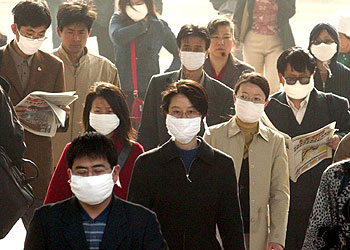Much to-do is being made recently of the emerging coronavirus outbreak in China, with different variations of the “Fallout: New Wuhan” theme competing for attention in the mainstream media. Various rumors floating around about the infection and fatality numbers being multiple times higher than what is being reported, along with photos and videos of overflowing hospitals and police roadblocks, has caused a large amount of attention to be paid to what is still a relatively small event.
While there is always reason to be concerned whenever a new pathogen seemingly appears out of nowhere, much of the media attention being generated by this amounts to visual clickbait, and lacks the historical context necessary for people to make an accurate judgement of what is happening. This may be the first time many people have heard of Coronavirus, but we have dealt with similar outbreaks of this before, and the history of those incidents will most likely be illustrative of our future with the current one.
SARS
Although Coronaviruses were discovered in the 1960s, and were identified as one of the causes of the common cold, the first time most of us would have heard about the Coronavirus family was at the beginning of 2003 with the SARS outbreak. Think of this one as Corona Extra. Emerging as the U.S. still had 9/11 and the anthrax attacks in recent memory, the sudden outbreak and spread of this virus caused a small panic globally. The first case appeared in southeastern China in late 2002, with the symptoms you have been hearing about on the news: dry cough, fever and tiredness. Symptoms similar to this began appearing in other parts of Southeast Asia, including Hong Kong, Vietnam and Taiwan, causing illnesses and deaths even in otherwise healthy people. Since it was winter, and the symptoms matched with many other viruses, the experts were slow to realize what was occurring was unusual, and due to a novel virus.
Finally, in March of 2003, authorities issued a global alert for this new virus, which they called Severe Acute Respiratory Syndrome, or SARS. The first cases in the U.S. and Canada were identified, with most of the infected having recently traveled to Asia. This escalated the panic, with the media predictably playing into the hype, and the authorities began planning for a world-wide pandemic. However, only two months later, all signs of the transmission of the virus in the U.S. had ceased. Signs of the virus in Asia disappeared two months after that.
Retroactive testing of the samples of suspected SARS cases revealed that many of the people, designated as having been infected, actually did not have the virus. The panic at the time caused many people, some healthcare workers included, to designate anybody that felt tired and had a cough as a potentially infected person. All told, roughly 800 people are believed to have died from the virus, with 8,000 people infected. To put this in context, it is believed the seasonal flu kills anywhere between 10,000 to 60,000 people a year in the U.S. alone. The source of the virus is vague, but was ultimately linked to civet cats being sold in Asian markets as a delicacy, although bats may have had a role in infecting the cats first (insert favorite Plum Island conspiracy theory here).
MERS
Coronavirus stayed out of the spotlight for the next decade, although novel ones did continue to pop up here and there and infect small clusters of people with severe illness, before disappearing again. It returned with a splash in 2012, with the virus that was ultimately given the name “Middle East Respiratory Syndrome Corona Virus,” or MERS. This one is more Corona Light. The first cases appeared in the Middle East in the summer and fall of 2012. Once again, a media panic ensued, with highlights of the old SARS epidemic being replayed, along with grim pronouncements of a worldwide pandemic. Unlike SARS, this virus did not grind to a halt immediately after appearing, with sporadic cases continuing to appear throughout the Middle East and in travelers from that area. It even made a prolonged appearance in South Korea in 2015.
However, just like SARS, it never really proliferated beyond its home area. Currently, around 450 people have died from this outbreak, with roughly 1,200 infections. This is a fairly high death rate for a disease, but it is still limited in spread. This outbreak was ultimately traced back to human interactions with camels (the type of “interaction” is unknown).
2019 Wuhan Virus
This brings us to the current outbreak causing such a kerfuffle. The outbreak was initially centered around a large wild game market, which meshes with the previous Coronaviruses that appear to have originated from game animals. Preferably, this virus does not turn into “Corona Export.” The virus was first detected in a sick patient at the end of December in 2019, and then exploded across Wuhan, infecting people in direct contact with sick patients, or healthcare workers treating the infected. Estimates vary widely, but as of this writing, there are roughly 1,000 confirmed cases, with over 20 deaths (officially), and more of both sure to come. This fatality rate is substantially below the rates for the previous two well-known outbreaks. Although person to person transmission has been confirmed in China, reports of infections in people in other countries have almost exclusively been linked to either people who entered the live game market in Wuhan, or were in hospitals which were treating affected individuals. Several cases have been detected in the U.S., but there has been no sustained transmission.
Much is being made of the Chinese government’s reaction to the outbreak. A total lockdown of Wuhan has been ordered, with no travel in or out of the city, along with several others. This has sparked much fear online that the government is deceiving us about the amount of cases and the severity of the illness. Stories on image boards are predictably circulating that appear to describe the end of the world starting in China. Skeptical reactions to anything being put out by the government are right and healthy in the Current Year. Having said this, not everything is always deeper than it appears. Sharing of disease outbreak information between countries has become difficult in recent decades due to issues such as future drug rights, patents and publication priorities, among many other complicating factors.
In this case, the Chinese government’s reaction can possibly be ascribed to a couple of different things. First off is the fact that China was heavily criticized during the SARS outbreak for reacting too slow, and not sharing information quickly. It is possible that they have this criticism in mind now, and are acting more decisively, knowing how important international trade is to their economy. Economically, they are in a stronger position than they were in 2003. Historically, China has placed a large value on saving face internationally, but international opinion may mean less to them now for events like these.
In addition, these are the type of actions you are able to implement in a country with a strong central authority that can remove all red tape whenever it feels like. Locking down cities with millions of people is unfortunate for those stuck inside who feel like they are reenacting Escape from New York, but it is also the type of action that many Western leaders dream of being able to pull off whenever they want, for better or worse. This lockdown is a better response than the U.S. gave during the recent Ebola outbreak, where the government refused to place a blanket ban even on air travel to the U.S. from the affected areas. Do not expect to see a ban on flights to the U.S. from Southeastern China for the same reason. Additionally, the fact that many people would be planning to travel during the upcoming Chinese new year is forcing their hand.
Given this previous history of Coronavirus outbreaks, it is likely that this outbreak will also flare hot, keep the media entertained for several news cycles, and then disappear again. This fits the pattern of most modern outbreaks which keep everyone scrambling. The Ebola outbreak in 2014 caused international alarm, and had the same pattern of isolated cases appearing in international airport screening areas. This, too, burned itself out before it could spread worldwide.
“Everything is Fine”
Of course, this is not the case with all outbreaks, and we may have all been jinxed by downplaying this. The 2009 Influenza pandemic started as a small outbreak in Mexico. Many, many novel influenza viruses appear every year, infect a few people, and then disappear. Unfortunately, Influenza spreads much easier than Coronavirus, and this specific virus caught hold and spread globally. Even with modern knowledge of infection controls, such as washing hands, covering your mouth and isolating ill people, very little could be done to halt the spread of the virus, and it became endemic around the globe up to the current day. It is unlikely, but not impossible, that this happens during the current outbreak. Besides not traveling to China, there are a few easy things you can collect now so that you are prepared long term for a future disease event.

First thing to buy is an N95 respirator (N99/N100/P95/P100 are also fine). Home improvement stores sell cheap packs of these, and they are just as good as masks the hospitals will use, if not better. Surgical masks are not going to work for this, and regular painters’ masks won’t either, you need the real deal. Next, get some exam gloves, the material isn’t really going to matter. Even food prep gloves would work in a pinch. Last, you need a spray bottle and some strong alcohol. A handle of grain alcohol is easiest to store, but you can get anything as long as it is above 140 proof (70%). Rubbing alcohol from the drug store also works. Household bleach could be used as a 1 in 10 solution, but it will not store as long. Mix the alcohol with water so it is down to 70% and add it to the spray bottle. Use this to soak your mask and your gloves after you’ve had to venture out into the wastelands and this should reduce much of your chances of infection. There are many other supplies you can find on prepping websites if you feel like it, but if the end of the world does happen in the next couple of months, these small preparations get you far ahead of everyone else.
It is all but certain that this new flavor of the month disease will have a terrible impact on some small number of people’s lives, but will probably not end up becoming an event that hits the reset button for humanity. Minimal preparations can and should be made by any responsible people to protect themselves and their family from reasonably foreseen risks. No single emergency will remove our need to plan ahead for our uncertain future, as convenient as that may seem to be. Our ancestors survived much worse than this on a routine basis and we will need the same fortitude for the world that is to come beyond this.
-By Dixie Anon

O I’m a good old rebel, now that’s just what I am. For this “fair land of freedom” I do not care at all. I’m glad I fit against it, I only wish we’d won, And I don’t want no pardon for anything I done.






But do line up quickly for you vaccination…
After a major pandemic, basement dwelling spergs will inherit the Earth.
The problem with these outbreaks is that they desensitize people. Everybody thinks the next one will just blow over like the last one but eventually there will be The Big One. Be wise. Be ready.